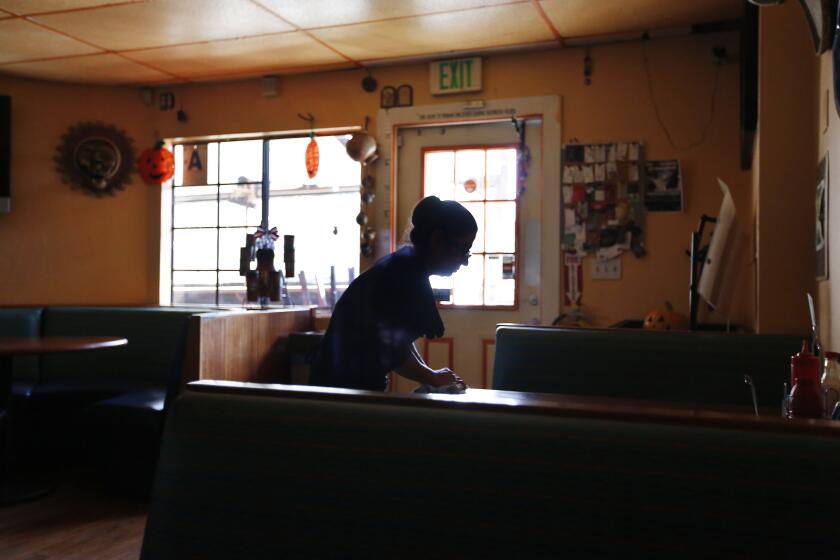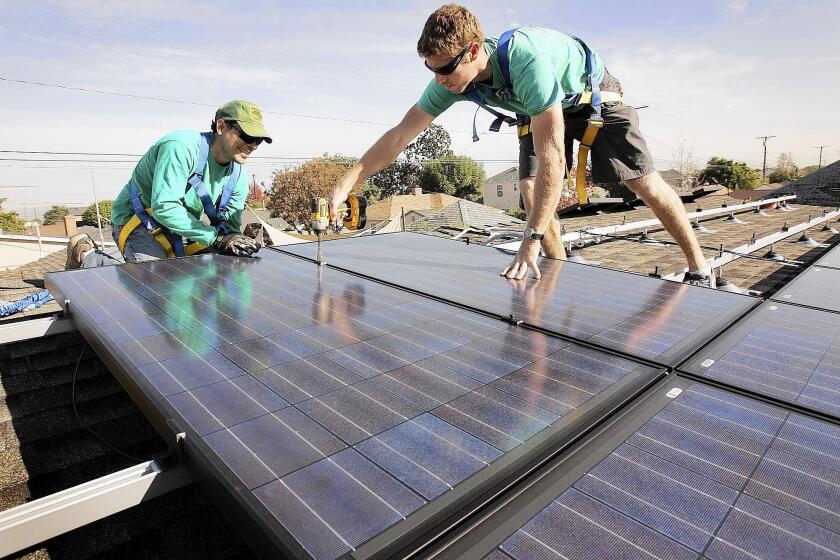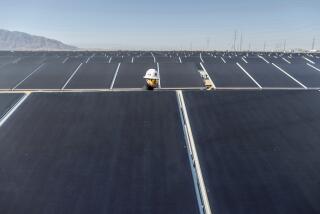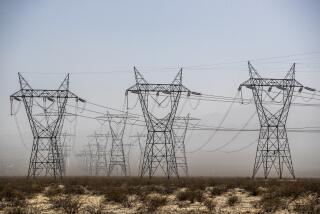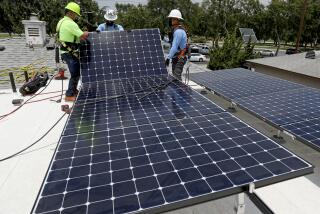California now has 1 million solar roofs. Are 1 million batteries next?

For Clovis Unified School District outside Fresno, the economics of solar power have been too good to pass up.
And for the solar industry, the district’s investments in sun-generated electricity have helped fuel a milestone 14 years in the making.
Clovis Unified has installed solar systems covering parking lots and play areas at 47 of the 52 school sites it operates — and more installations are planned. Five high schools also have lithium-ion batteries, which store energy for use after the sun goes down.
Michael Johnston, Clovis Unified’s associate superintendent of administrative services, said the district was avoiding $4 million a year in costs through lower energy bills. The solar panels also provide much-needed shade and help to reduce air pollution in the smoggy San Joaquin Valley.
“If we’re going to use the dollars we have wisely and be good stewards of public dollars,” Johnston said, “then this is something we can’t ignore.”
The solar panels and energy storage system at Buchanan High School in Clovis provided the backdrop Thursday for a gathering of clean energy advocates and elected officials. They were celebrating a landmark that California reached this summer: 1 million small-scale solar systems.
The event featured former Gov. Arnold Schwarzenegger, who in 2005 set a statewide target of 1 million solar installations and launched a program that would ultimately set aside more than $3 billion for solar rebates. In an interview, Schwarzenegger credited those rebates with growing the market.
“Exactly what we predicted would happen did happen, which is that the price of solar came down. So now we don’t need any more subsidies,” he said.

Even as they celebrated, clean energy advocates were talking about what would come next — and warning that climate change demands faster action.
Schwarzenegger’s successor, former Gov. Jerry Brown, warned that rising global temperatures posed a serious threat to California. He listed rising seas, the spread of disease-carrying insects and an increase in cross-border migration as a few of the many climate change effects relevant to the Golden State.
“We’re in big trouble,” Brown said at the event. “And if we don’t do something, things will get a lot worse.”
Now that California has reached 1 million solar roofs, some activists are looking at battery storage as the next frontier for lawmakers.
Dan Jacobson, director of Environment California, thinks the state should aim to install 1 million batteries by 2025. Those systems could store solar power for use in the evening — and help homes keep the lights on when utility companies intentionally shut off power to reduce the risk of wildfire ignitions.
Jacobson said state policies could help spur the nascent battery storage market in much the same way they did for rooftop solar power.
“A rebate program would create the incentive that we need to drive down prices and increase the numbers,” Jacobson said.

Austin Perea, a senior analyst at the energy research firm Wood Mackenzie, said 1 million batteries by 2025 would be difficult but not impossible.
The rooftop solar market is already growing fast, with Wood Mackenzie reporting Thursday that California was one of 15 states to install record amounts of residential solar in the third quarter of 2019. The firm attributed the surge in part to the growing use of “public safety power shut-offs” by Pacific Gas & Electric and other utilities, with installers reporting that as many as 40% of new customers want to pair energy storage with their solar panels, Perea said.
PG&E’s CEO has said wildfire-prevent blackouts could continue for another decade.
State subsidies could help reduce battery prices in much the same way they helped drive down solar costs by growing demand, Perea said.
“Costs only came down because [California] provided sufficient financial incentive for those manufacturers to scale up,” he said.
But Perea cautioned that several factors outside Sacramento’s control would affect the home storage market.
One of those factors is the federal investment tax credit, which is scheduled to gradually drop from 30% in 2019 to zero in 2022 for residential solar-plus-storage projects. The solar industry has been lobbying for an extension, with House Democrats unveiling legislation last month that would extend the tax credit an additional five years.
Another policy that has fueled the growth of rooftop solar is net energy metering, which requires investor-owned utilities to compensate rooftop solar customers at retail rates for the electricity they export to the grid.
The California Public Utilities Commission maintained net metering over the objections of PG&E, Southern California Edison and San Diego Gas & Electric in 2016. But the agency is expected to begin reconsidering the rate structure next year.
Officials postponed a decision that critics said would cripple the state’s home solar mandate.
Some experts say the costs of net metering and other policies that promote rooftop solar and storage may outweigh the benefits.
James Bushnell, an energy economist at UC Davis, said solar-friendly electricity rate structures had allowed rooftop solar customers to avoid paying their fair share of the costs of maintaining the bulk power grid. If state officials continue requiring utilities to offer net metering, those power grid costs will increasingly be shouldered by homes and businesses that don’t have solar panels — especially if solar customers also add batteries, Bushnell said.
For Bushnell, public support for rooftop solar and home batteries makes little sense when large-scale solar farms and storage systems are cheaper.
“From a societal perspective, that’s a tremendous waste of resources,” he said.

Rooftop solar advocates disagree. They say distributed energy resources reduce the need for polluting power plants and costly grid investments.
California’s millionth solar system was a long time coming for Bernadette Del Chiaro, who lobbied the Legislature to approve Schwarzenegger’s Million Solar Roofs initiative in 2006. She said the decision to hold Thursday’s event at a Central Valley high school showed how mainstream solar had become.
“It defies all stereotypes that people tend to think about solar. Certainly this was true in 2006,” said Del Chiaro, who now serves as executive director of the California Solar and Storage Assn., in an interview before the event. “My most quoted quote back then was, ‘People think solar’s just for backwoods hippies and Malibu millionaires, but it’s not. And we’re going to make it more mainstream through this program.’ And it has absolutely come true.”
Data collected by the state back up that claim.
Of the 950,000 solar projects in a database covering most of California, nearly 400,000 are located in inland counties. And although the vast majority of those solar projects are on residential rooftops, about a third of the overall power capacity is installed at businesses, schools and government properties.
Around 6.6% of utility customers in California have installed solar, according to additional data collected by the California Solar and Storage Assn.
There are big differences across the state. For instance, 150,000 of the 1.4 million homes and businesses served by San Diego Gas & Electric have gone solar, compared with just 34,000 customers of the Los Angeles Department of Water and Power, which has roughly the same number of accounts as SDG&E.
An average rooftop solar system in California costs $3.50 to $4 per watt, Del Chiaro said, which at the high end comes out to $20,000 for a five-kilowatt system. Homes typically see a “payback period” of six to seven years, after which cumulative energy-bill savings surpass the up-front costs of the panels.
“We’re just at the beginning stages of developing that market and getting batteries tied to every solar panel,” Del Chiaro said. “It’s going to take the same level of commitment by the state to make that happen.”

